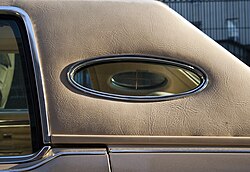
An opera window is a small fixed window usually behind the rear side window of an automobile, originating with small windows mounted in the fabric of a folding top on horse-drawn carriages. They are typically mounted in an automobile's C-pillar, usually within a padded, vinylled section of the roof as a reference to the original location in a fabric roof. [1] The design feature was popular, mainly with domestic U.S. manufacturers but also seen in Japan, during the 1970s and early 1980s.. [1]
Contents
The origin was from "opera" vehicles of around 1915 with occasional collapsible seating for extra passengers. [2] The opera window was also a feature on "formal roof" and limousine models with higher than a normal roof to accommodate passengers with top hats. [2]







